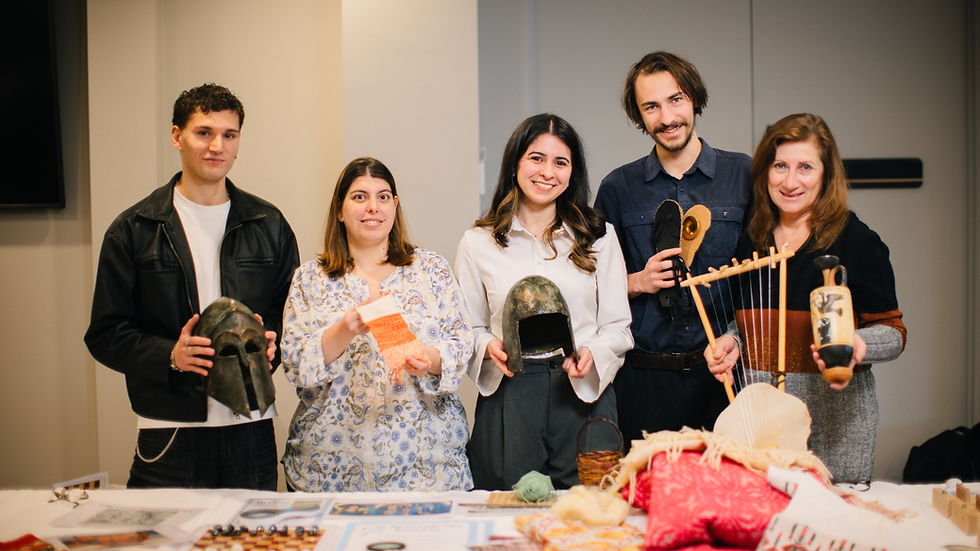Perfectly Perplexing Pyxides
- Sara Prica
- Dec 6, 2017
- 3 min read
Updated: Oct 8, 2021

Dating its beginnings to roughly 3000 BCE, the Early Bronze Age of the Cycladic Islands saw the rise of a rich and complex civilisation in the Aegean Sea pre-dating the Minoans on Crete in the south.
Integral to the understanding of any society is the manner in which the dead were treated. Burials from the Early Cycladic, primarily Early Cycladic I (ECI) and Early Cycladic II (ECII), period most commonly feature pyxides such as the one in our collection. Pyxides are spherical or cylindrical containers with a lid, at times found with lugs on either side, decorated in various patterns and constructed out of variety of materials. ECI saw the appearance of basic pyxides with rectilinear incisions, possibly in imitation of wood or basketry in regards to herringbone patterns, with the geometric designs filled with a chalky white substance. Pyxides became more squat in ECII and the first painted decorations appeared, though the patterns remained simple.
Other than pyxides, other items commonly found in Cycladic burials during this period include marble vases and figurines, small pottery vases, bronze tools, silver vessels, bone and stone jewellery, razors, spatulae, tweezers, pierced beads, and lead models and figurines.
The dead were distinctly separated from the living, but the consideration taken in choosing the location of cemeteries, in that they were located on infertile slopes to preserve their structure and near settlements and thus the living, indicates the importance of the dead and some manner of theological belief in an afterlife. The graves themselves were primarily of the cist variety; stone-lined pits dug into the ground wherein the body or bodies would be placed on their side in a contracted position and any grave goods would then be placed within and near the head. A lack of settlement items deters from a holistic understanding of whether the items found in graves were used during an individual’s lifetime, if they were produced solely for burials or, perhaps, a mixture of the two. There does exist an apparent class divide amongst burials when considering the quality and size of graves and of grave goods and it remains uncertain what, if anything, pyxides held within them, though their compact size does lend itself to the belief that they would have contained jewellery and possibly cosmetics if not general storage for ancient knick-knacks, in keeping with the practise of burying the dead with items that appear to have been personal or relevant in some way in their lives and livelihoods.
The commonplace appearance of pyxides within burials, as opposed to items such as weapons, attests to an important position within Cycladic society and though their coupling alongside the first ‘luxury’ good of the Cyclades, marble figurines, points to a status indicator, it is very likely that pyxides made out of perishable material such as wood existed for those of a lower socio-economic status. The further appearance of Cycladic-type pyxides on Crete, particularly in Knossos, indicates not only trade relations but the value these items held for
Alternatively, if pyxides held nothing, or if there is no indication of them acting as a container for physical items, then it may have acted symbolically. On the one hand, it would lend itself to the inclusion of a strictly religious or spiritual object that tied in with theological aspects of the afterlife and was specific for that purpose. Alternatively, it would be in contrast to the existing items that held personal meaning to the deceased and was used while they were alive
Overall, these cylindrical pyxides were considered integral enough to Cycladic culture to merit a fairly regular appearance within the resting place of the dead. Though their specific purpose continues to elude us, it is reasonable to assume that they held an important meaning to the Cycladic people, either in an ephemeral or practical manner. These pyxides present an intimate, though perplexing, look into the social, cultural, economic, and spiritual life of the Cycladic peoples, giving a glimpse of the values they held through as innocuous an item as what is essentially, to us, a container.
FURTHER READING
Barber, R.L.N., The Cyclades in the Bronze Age, Gerald Duckworth & Co., London, 1987.
Carter, T., ‘The Theatrics of Technology: Consuming Obsidian in the Early Cycladic Burial Arena’, Archaeological Papers of the American Anthropological Association, vol.17(1), pp.88-107, 2007.
Cylindrical pyxis, Museum of Cycladic Art, 2016, https://www.cycladic.gr/en/exhibit/ng0090-kilindriki-pixida
Dickinson, O., The Aegean Bronze Age, Cambridge World Archaeology, The Press Syndicate of the University of Cambridge, UK, 1994.
Immerwahr, S.A., Athenian Agora XIII: The Neolithic and Bronze Ages, American School of Classical Studies at Athens, 1971.



